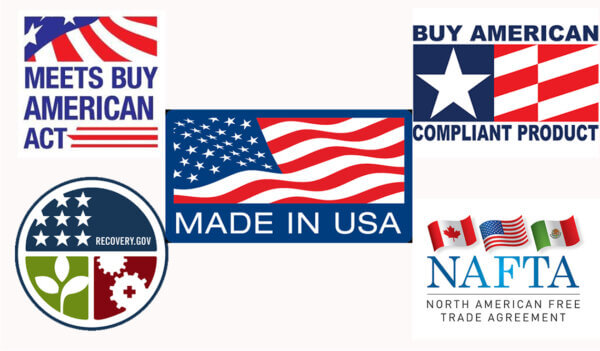Made in USA What Are Requirements for Electrical Fittings?
When Big Brands Become Big Box Offshore Stores For Profit, Why It’s Wrong, Unethical and Even Illegal
Today’s Electrical Industry supply chains are stuffed with “Camouflaged Fittings”. Many of the fittings being supplied today are from foreign countries such as China, India, and Turkey. These fittings are being sold by “old, established and thought reliable big brands without distributors, contractors and end users knowing what they are receiving. These manufacturers do not mention the country of origin on their catalog sheets or within other literature. The product itself is not marked with country of origin. It all falls under the shaded guize of “don’t ask, don’t tell” or as we call it Camouflaged Fittings. The only known origin is a simply a country in smaller fonts shown someone over the big branded box label.
Why They Do It? One Reason – The profit to be made by those manufacturers who shut down production in this country. They are now simply a “big box store” for those off-shore manufacturers. Read More why many times this is illegal even when Made in USA is not in the specification.
First and Foremost Don’t Buy Their Claims Unless It’s True
Within the last several years, the Federal Trade Commission has increased its enforcement actions against companies that mislead with a “Made In USA” claim. If your company is involved in installing or buying manufactured electrical products with possible foreign content, or assembled offshore or locally, it is crucial that you are aware of these regulations. FTC enforcement action can have far-reaching consequences, that could lead to significant fines and penalties. It takes years to build trust with your customers. It only takes a label with misleading claims to destroy it.
As a distributor, contractor or specifyer know the rules and more importantly the law. Today’s marketplace is frought with old line brands selling offshore products under the guise of “don’t tell if they don’t ask”. The contractor and end user must be careful attention to spec sheets, packaging and purchase orders to avoid inspection rejections and “tearouts”.

For manufacturers these days, it’s not uncommon to express their patriotism by claiming their products are “Made In USA.” But, ongoing FTC enforcement action suggests that many firms are unaware – or even choose to ignore – the strict rules the FTC has set forth against making false or misleading claims that their product is of U.S. origin.
Under Section 5 of the Federal Trade Commission Act, the FTC is granted enforcement powers to prevent unfair or deceptive marketing practices. This also includes product origin claims. Accordingly, a product marketed as “Made In USA” must be “all or virtually all” made in the USA. Companies that do not abide by these regulations are at risk of significant FTC enforcement action including fines and other penalties.
UNQUALIFIED & QUALIFIED US-ORIGIN CLAIMS
In its document “Complying With The Made In USA Standard,” the FTC spells out two categories under which companies can make the “Made In USA” claim: the first is the Unqualified claim; and the second is the Qualified claim.
Under an Unqualified claim, the product must comply with the “all or virtually all” requirement. This means that “all significant parts and processing that go into the product must be of U.S. origin. That is, the product should contain no — or negligible — foreign content.”
Other factors that determine the “all or virtually all” requirements include:
- The location of processing or final assembly
- The percentage of U.S. manufacturing costs
- Remoteness of foreign content.
- Final assembly in the United States.
WHAT IS A QUALIFIED CLAIM: “SOME – BUT NOT ALL – MADE IN USA”
A Qualified “Made In USA” claim indicates that a product isn’t completely of domestic origin by outlining the extent of a product’s processing or content. FTC examples of Qualified claims are:
- “60% U.S. content.”
- “Made in USA of U.S. and imported parts.”
U.S. CUSTOMS SERVICE REQUIREMENTS
Under the Tariff Act of 1930, the U.S. Customs Service requires that products manufactured overseas, or “substantially transformed abroad,” must be labelled or marked with the overseas country of origin. The Customs Service considers “substantial transformation” as the process that changes a product with a character, name, and use that is different than that which existed prior to the process. An example of this would be a company that imports sugar from Honduras, nuts from India, chocolate from Switzerland. Though the flour and butter are from U.S. sources. These ingredients would constitute a substantial transformation when combined to become chocolate chip cookies. Though the cookies themselves are produced in an American facility, the company is required to indicate the source of the ingredients on its packaging and in its marketing materials.
Equally important, the Customs Service requires “the foreign country of origin to be preceded by “Made in,” “Product of,” or words of similar meaning when any city or location that is not the country of origin appears on the product.” For instance, stating a product is “Made in USA from Imported Parts” or “Assembled in USA” would not be misleading.
Example: Apple states that its iPhone is “Designed by Apple in California. Made in China.” This meets the U.S. Customs Service requirements.
